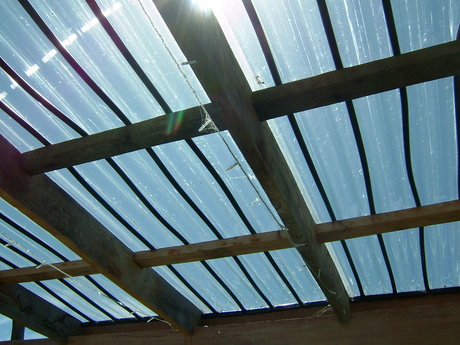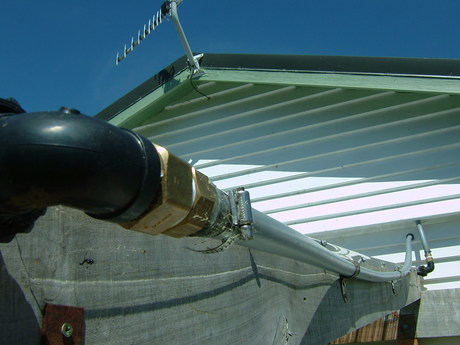Building a solar water heater
While I was planning my deck roof some months back I made provision for the future and inevitable construction of a passive solar hot water system. This is one of the most obvious applications for solar energy gathering as it does not require expensive or complex components and is basically zero maintenance.
Because our hot water cylinder is located in the ceiling (above the height of my deck roof) I can exploit the laws of physics that cause hot water to rise above cooler water and cycle (thermosiphon) without the aid of a pump.
 My collection device measures 3 meters from top to bottom and 2.4 meters wide. It is constructed with 25mm diameter header and footer pipes connected with 15 vertical pipes of 16mm diameter. The overall solar collection surface area is not huge and the angle of the setup is not optimal but I can confirm that it functions.
My collection device measures 3 meters from top to bottom and 2.4 meters wide. It is constructed with 25mm diameter header and footer pipes connected with 15 vertical pipes of 16mm diameter. The overall solar collection surface area is not huge and the angle of the setup is not optimal but I can confirm that it functions.
I used off the shelf reducing branch T joints (25mm to 16mm) to construct the header and footer pipes and connected them with short lengths of agricultural plastic pipe.
The vertical heating pipes are fitted into the ridges in the corrugated clear plastic that covers the deck and are suspended by the header and footer at each end and the 3 roof purlins at 75cm intervals. My intention is to increase performance by adding another layer of clear plastic sheeting on the underside of the collector pipes to encase the devise in a 'bubble' of air and trap the air from being carried away by air currents.
 From my initial tests I can see that on a good day this setup can raise the temperature at the hot tap by around 10 degrees Celsius. At this stage I have not applied the 'backing' plastic or insulated the pipes that travel through the ceiling (about 8 meters) to connect to the cylinder.
From my initial tests I can see that on a good day this setup can raise the temperature at the hot tap by around 10 degrees Celsius. At this stage I have not applied the 'backing' plastic or insulated the pipes that travel through the ceiling (about 8 meters) to connect to the cylinder.
So far this has cost me just under $500 which is a lot less than the sophisticated evacuated glass tube versions but then it is also much less efficient.
My next move is to add the backing plastic which is 0.8mm clear plastic sheeting. I want to allow light to pass through in winter, another reason for having the vertical heating pipes in only every second ridge. Also, to add insulation around the pipes that connect the panel to the cylinder. These improvements will hopefully add a few few more degrees of heat out the tap.
This photo shows the header and footer pipes connecting into the house. Note my use of hose clamps and glue.... Yes I know I should have used one of those special crimping tools but I was not able to get my hands on one that could to the 28mm pipe. Never mind, it doesn't seem to be leaking. I have since insulated both of these pipe in the hope of retaining just a little bit more of the heat.



